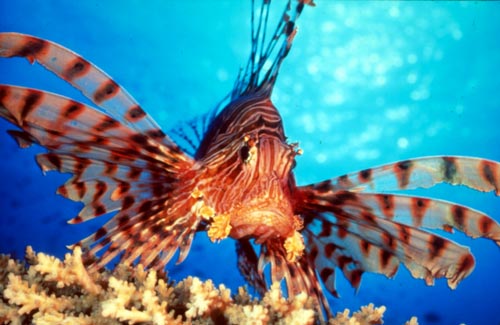Why 'crucial?'
Because a human's touch can be fatal to an entire species; and on the flip side, marine life, too, can be fatal for humans.
The lionfish, while not fatal, does fall in the "danger" category, as it is a poisonous aquatic predator with an incredibly painful sting. The sting can last up to two days and cause some swelling. Immediately, the sting can be treated by frequently immersing the affected area in water no warmer than 114 degrees Fahrenheit until symptoms subside.
Because of its deceptive beauty and its large Panamanian population, our scuba dive masters had to draw special attention to its danger when instructing the Water & Wave and Tri-Country students last week - and OB USA this week - in Bocas del Toro, Panama. It was a helpful lesson because they did, in fact, report having swum very closely with the colorful fish.

The large and growing population of this South Pacific and Indian Ocean species has become a major environmental issue, not only in Panama, but in the Caribbean and all the way up the US east coast.
It's invasion in this hemisphere is a unique and interesting story.
In 1992, an aquarium broke during Hurricane Andrew and is believed to have released a few lionfish into the Atlantic Ocean. Since then, reports have begun to come in regularly from divers in Florida, all the way up to Massachusetts, and now all the way down to Panama these past 20 years. (Luckily for the northern states, the species’ intolerance of cold winter temperatures means it is unlikely to survive in these areas.)
This is a problem to the marine environment because lionfish are voracious predators that quickly adapt to eating new types of food, and they have no native predators in Atlantic or Caribbean waters. Lionfish have venomous dorsal, ventral, and anal spines that can deter predators and injure humans. They can reproduce year-round and are relatively resistant to parasites, giving them an advantage over native species. They are also fast growing and can outgrow and out-compete native species for food and space. Lionfish are eating fish, invertebrates and coral in large quantities, including juvenile spiny lobsters, parrotfish, and the Atlantic coral reefs. Reefs depend on some of the decreasing reef species to prevent seaweed and macroalgae from overgrowing the corals.
There is no way to really rid the waters of this species, but different diving groups and governements are playing their own part in trying to alleviate the problems. And actually, while the students were in Panama last week, the local paper published an article educating civilians about lionfish and urging people to kill the predator when they get the chance!
A recent article in Smithsonian Magazine reported, "Some experts believe that lionfish are so widespread that their effect on the ecosystems of the Western Atlantic will be almost impossible to reverse."

No comments:
Post a Comment